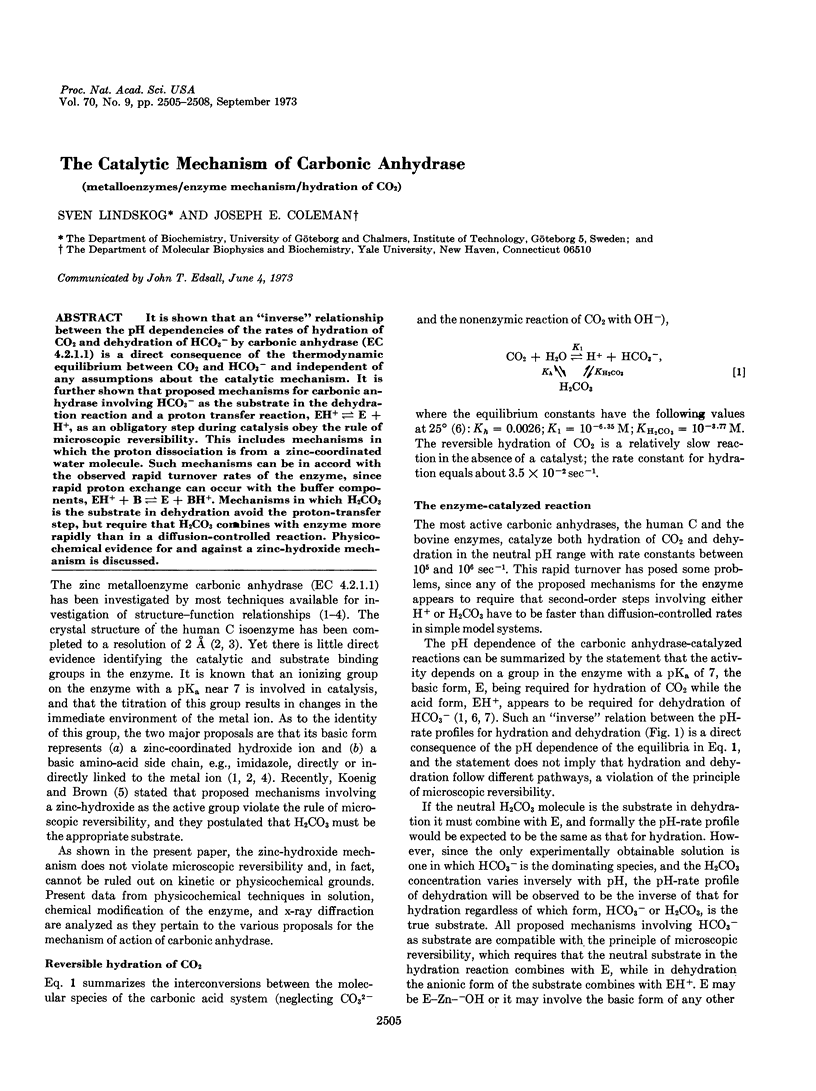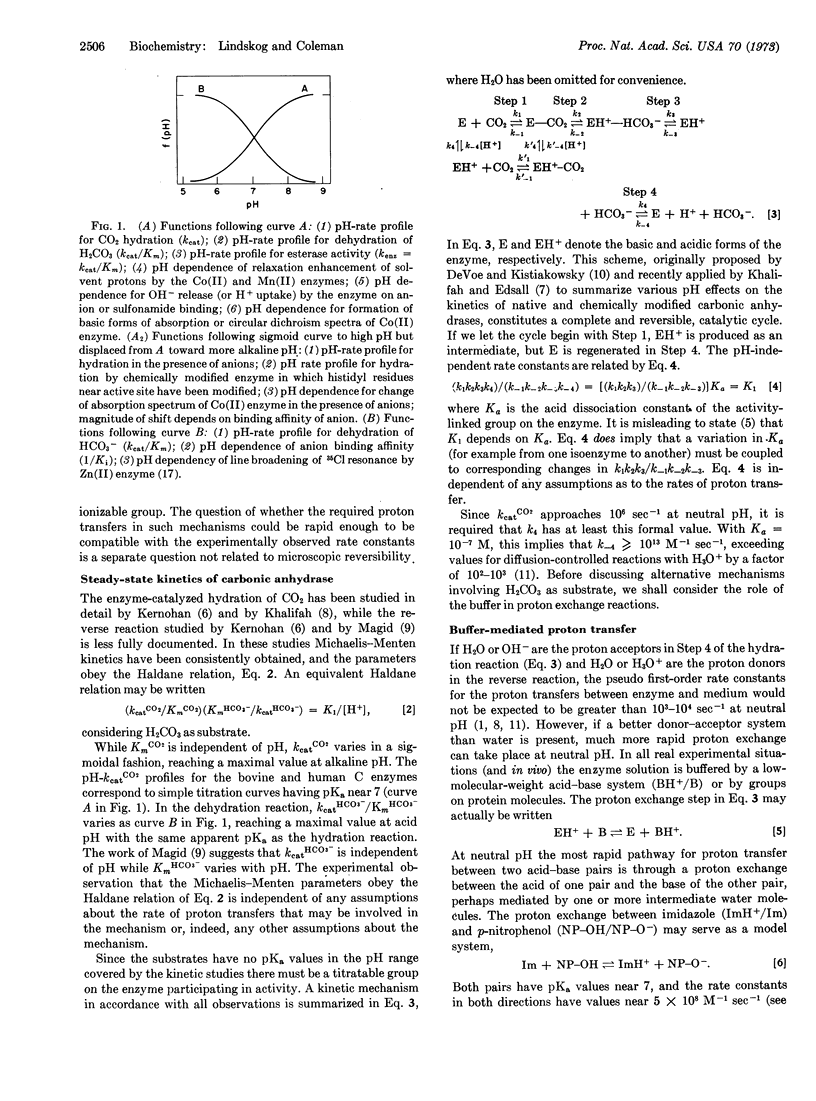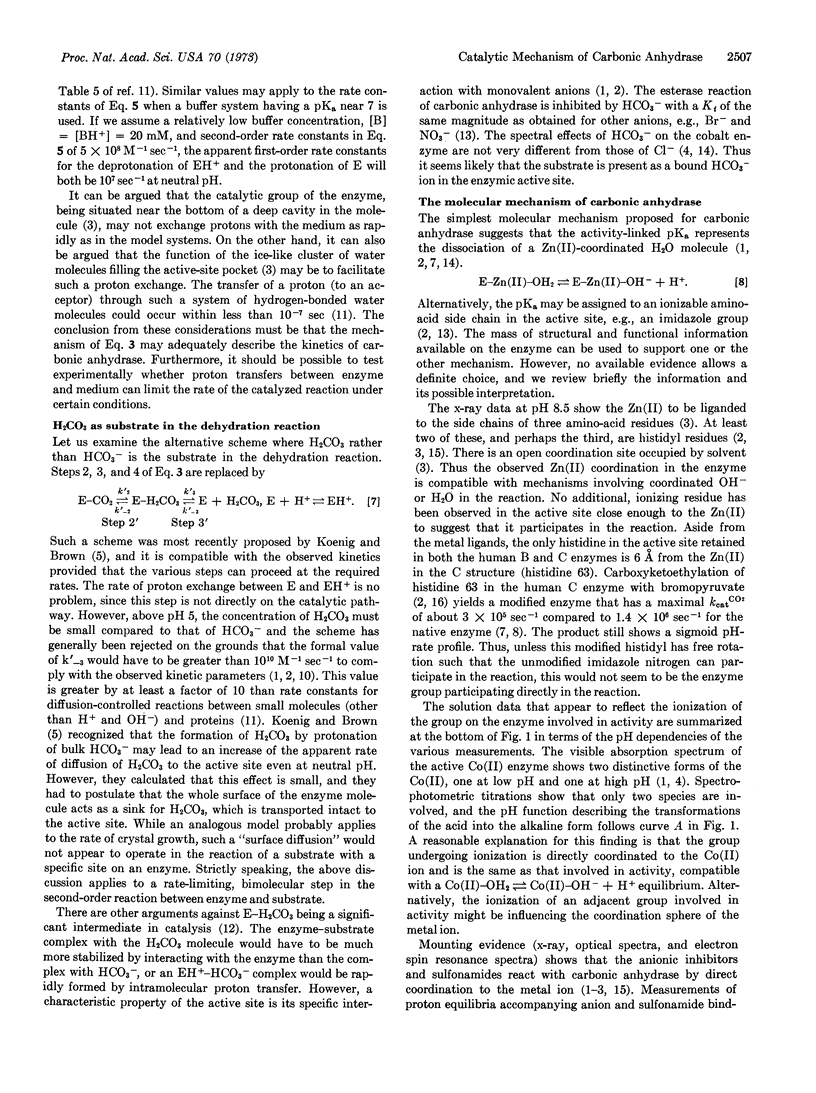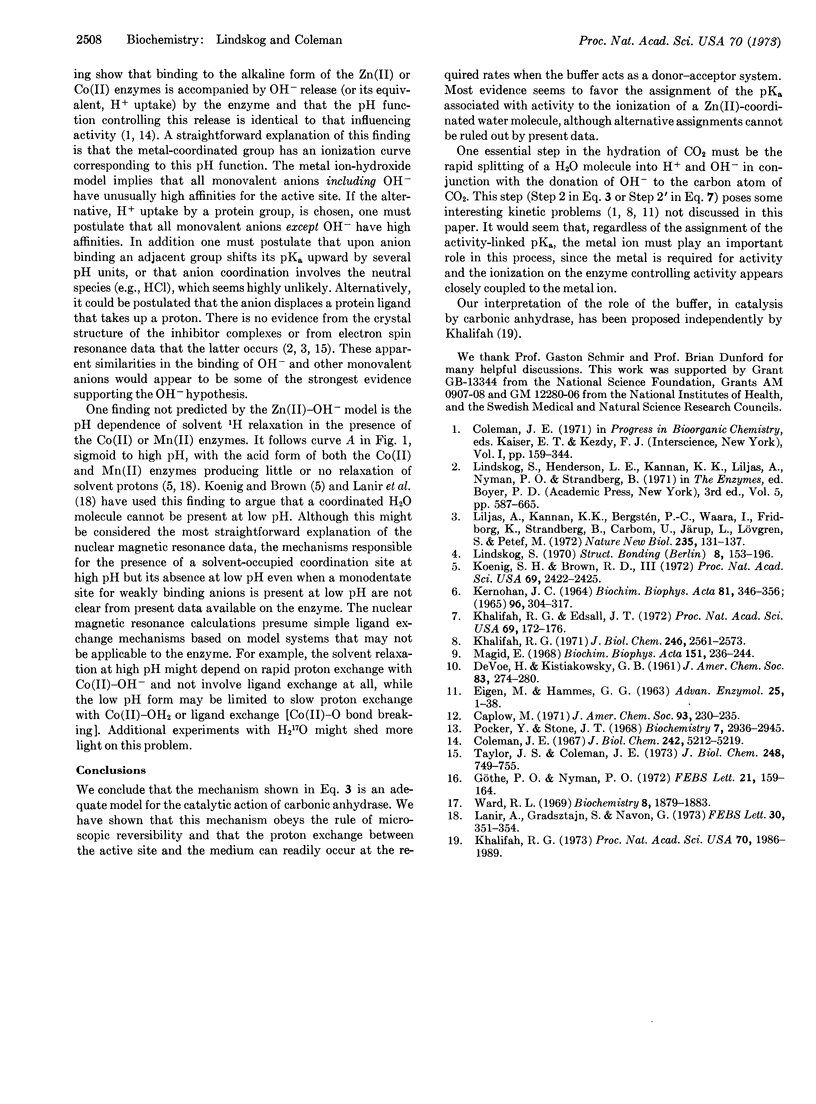Abstract
It is shown that an “inverse” relationship between the pH dependencies of the rates of hydration of CO2 and dehydration of HCO3- by carbonic anhydrase (EC 4.2.1.1) is a direct consequence of the thermodynamic equilibrium between CO2 and HCO3- and independent of any assumptions about the catalytic mechanism. It is further shown that proposed mechanisms for carbonic anhydrase involving HCO3- as the substrate in the dehydration reaction and a proton transfer reaction, EH+ ⇌ E + H+, as an obligatory step during catalysis obey the rule of microscopic reversibility. This includes mechanisms in which the proton dissociation is from a zinc-coordinated water molecule. Such mechanisms can be in accord with the observed rapid turnover rates of the enzyme, since rapid proton exchange can occur with the buffer components, EH+ + B ⇌ E + BH+. Mechanisms in which H2CO3 is the substrate in dehydration avoid the proton-transfer step, but require that H2CO3 combines with enzyme more rapidly than in a diffusion-controlled reaction. Physico-chemical evidence for and against a zinc-hydroxide mechanism is discussed.
Keywords: metalloenzymes, enzyme mechanism, hydration of CO2
Full text
PDF



Selected References
These references are in PubMed. This may not be the complete list of references from this article.
- Caplow M. Bromine catalysis for carbon dioxide hydration and dehydration and some observations concerning the mechanism of carbonic anhydrase. J Am Chem Soc. 1971 Jan 13;93(1):230–235. doi: 10.1021/ja00730a038. [DOI] [PubMed] [Google Scholar]
- Coleman J. E. Mechanism of action of carbonic anhydrase. Subtrate, sulfonamide, and anion binding. J Biol Chem. 1967 Nov 25;242(22):5212–5219. [PubMed] [Google Scholar]
- EIGEN M., HAMMES G. G. ELEMENTARY STEPS IN ENZYME REACTIONS (AS STUDIED BY RELAXATION SPECTROMETRY). Adv Enzymol Relat Areas Mol Biol. 1963;25:1–38. doi: 10.1002/9780470122709.ch1. [DOI] [PubMed] [Google Scholar]
- Göthe P. O., Nyman P. O. Inactivation of human erythrocyte carbonic anhydrases by bromopyruvate. FEBS Lett. 1972 Mar 15;21(2):159–164. doi: 10.1016/0014-5793(72)80127-3. [DOI] [PubMed] [Google Scholar]
- Khalifah R. G. Carbon dioxide hydration activity of carbonic anhydrase: paradoxical consequences of the unusually rapid catalysis. Proc Natl Acad Sci U S A. 1973 Jul;70(7):1986–1989. doi: 10.1073/pnas.70.7.1986. [DOI] [PMC free article] [PubMed] [Google Scholar]
- Khalifah R. G., Edsall J. T. Carbon dioxide hydration activity of carbonic anhydrase: kinetics of alkylated anhydrases B and C from humans (metalloenzymes-isoenzymes-active sites-mechanism). Proc Natl Acad Sci U S A. 1972 Jan;69(1):172–176. doi: 10.1073/pnas.69.1.172. [DOI] [PMC free article] [PubMed] [Google Scholar]
- Khalifah R. G. The carbon dioxide hydration activity of carbonic anhydrase. I. Stop-flow kinetic studies on the native human isoenzymes B and C. J Biol Chem. 1971 Apr 25;246(8):2561–2573. [PubMed] [Google Scholar]
- Koenig S. H., Brown R. D., 3rd H 2 CO 3 as substrate for carbonic anhydrase in the dehydration of HCO 3 . Proc Natl Acad Sci U S A. 1972 Sep;69(9):2422–2425. doi: 10.1073/pnas.69.9.2422. [DOI] [PMC free article] [PubMed] [Google Scholar]
- Lanir A., Gradsztajn S., Navon G. Proton magnetic relaxation in solutions of manganese-carbonic anhydrase. FEBS Lett. 1973 Mar 15;30(3):351–354. doi: 10.1016/0014-5793(73)80686-6. [DOI] [PubMed] [Google Scholar]
- Liljas A., Kannan K. K., Bergstén P. C., Waara I., Fridborg K., Strandberg B., Carlbom U., Järup L., Lövgren S., Petef M. Crystal structure of human carbonic anhydrase C. Nat New Biol. 1972 Feb 2;235(57):131–137. doi: 10.1038/newbio235131a0. [DOI] [PubMed] [Google Scholar]
- Magid E. The dehydration kinetics of human erythrocytic carbonic anhydrases B and C. Biochim Biophys Acta. 1968 Jan 8;151(1):236–244. doi: 10.1016/0005-2744(68)90178-2. [DOI] [PubMed] [Google Scholar]
- Pocker Y., Stone J. T. The catalytic versatility of erythrocyte carbonic anhydrase. VI. Kinetic studies of noncompetitive inhibition of enzyme-catalyzed hydrolysis of p-nitrophenyl acetate. Biochemistry. 1968 Aug;7(8):2936–2945. doi: 10.1021/bi00848a034. [DOI] [PubMed] [Google Scholar]
- Taylor J. S., Coleman J. E. Electron spin resonance of 63 Cu and 65 Cu carbonic anhydrases. Resolution of nitrogen ligand superhyperfine structure. J Biol Chem. 1973 Feb 10;248(3):749–755. [PubMed] [Google Scholar]
- Ward R. L. 35C1 nuclear magnetic resonance studies of a zinc metalloenzyme carbonic anhydrase. Biochemistry. 1969 May;8(5):1879–1883. doi: 10.1021/bi00833a016. [DOI] [PubMed] [Google Scholar]


